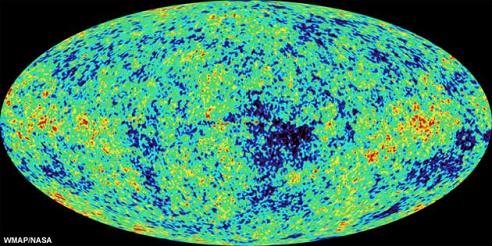Michal Levinstein, Israel Astronomical Society

Direct link to this page: https://www.hayadan.org.il/yekum250605.html
Neutrinos are tiny particles that can penetrate through the center of the Earth without leaving even a whisper. Every second, billions of them "rain" down and up from outer space.
Some of these cosmic ghosts were present in the first seconds of the universe's formation. Now for the first time, density fluctuations have been observed in the oldest neutrinos.
"We know there's an ocean of neutrinos out there, but what we've proven is that there are ripples in it," says Roberto Trotta of the University of Oxford. The discovery provides further confirmation of the standard cosmological picture, such as the fundamental particle theory.
Neutrinos are subatomic particles that have no electrical charge and have a tiny mass. It is extremely difficult to learn about them, because they rarely interact with the rest of the world.
According to the standard theory, neutrinos were created in huge numbers in the Big Bang. These so-called "background" neutrinos do exist: 2,500 of them populate every cubic inch in the universe.
Trotta and Alessandro Melchiorri (Alessandro Melchiorri) from the University of La Spezia in Rome found evidence in the universe's early past for wrinkles in the neutrino background. "Finding the neutrino particles that were present in the Big Bang was like the 'Holy Grail' for cosmology," says Scott Dodelson of the Fermilab Theoretical Astrophysicist Group. "This is another piece of indirect proof."
In addition to supporting the Big Bang theory, the ripples provide a unique test of neutrino physics.
Elusive prey
To detect individual neutrinos, scientists use massive detectors that are sometimes made of water or ice. Billions of particles pass through these particle traps unhindered, but sometimes the elusive prey gets stuck and trapped.
The neutrino particles detected in this way - coming from the sun, or from cosmic radiation, or from distant explosions - have millions of times higher energy than the other neutrino particles found in the background. The rest lost most of their energy as the universe expanded and cooled and so cannot be detected by any detector.
That's why Trotta and Melchiuri looked for the effect that the background particles leave on another relic of the early universe - the cosmic background radiation.
ripples and lumps
The cosmic background radiation is a kind of picture of the universe as it was 380,000 years after the big bang - rather boring, without galaxies or stars - with tiny fluctuations in the density of matter (1 in 100,000).
The associations (clumps) left their mark on temperature changes in the cosmic background radiation. Light emitted from a dense mass will appear - after a journey of billions of light years - as a hot spot in the background radiation. Astronomers made a detailed map of such spots using NASA's Wilkinson Microwave Anisotropy Probe (WMAP) in 2003.
Although the clumps of matter were initially small, gravity over time caused them to solidify to the point of forming galaxy clusters, suns, and everything in between.
Neutrinos are a relatively minor player in this part of the story, as they rarely interact with matter. But collectively, the gravitational drag of the ripples can affect the clumps. "Neutrino particles cannot 'talk' to matter or photons directly, but they can affect the cosmic background radiation through their gravity," says Dudelson.
Trotta and Melchiori showed that there is evidence for neutrino ripples in the cosmic background radiation data. Basically, the neutrino density tends to be smooth - so fluctuations don't last long. "When neutrinos are ironed out," says Trota, "they are dragged into the material and thus effectively increase the amount of small clumps."
From very large to very small
The discovery of the ripple creates a conflict with theories that predict certain neutrino interactions that are not found in the standard model of particle physics. These theories predict a smoother neutrino density as a result of the additional interactions. To a considerable extent, the ripples - which at the time were 100,000 light-years in size - tell us something precisely about physics on orders of magnitude smaller than an atom.
"We use the entire universe as a particle physics experiment," says Trota. who added that measuring the neutrino ripples is currently the best way to study this area of neutrino physics. The research is about to be published in the journal Physical Review Letters.
For news on the subject at Space.com
The Israeli Astronomical Society
Yadan astrophysics 1 - the universe
https://www.hayadan.org.il/BuildaGate4/general2/data_card.php?Cat=~~~172612094~~~60&SiteName=hayadan
